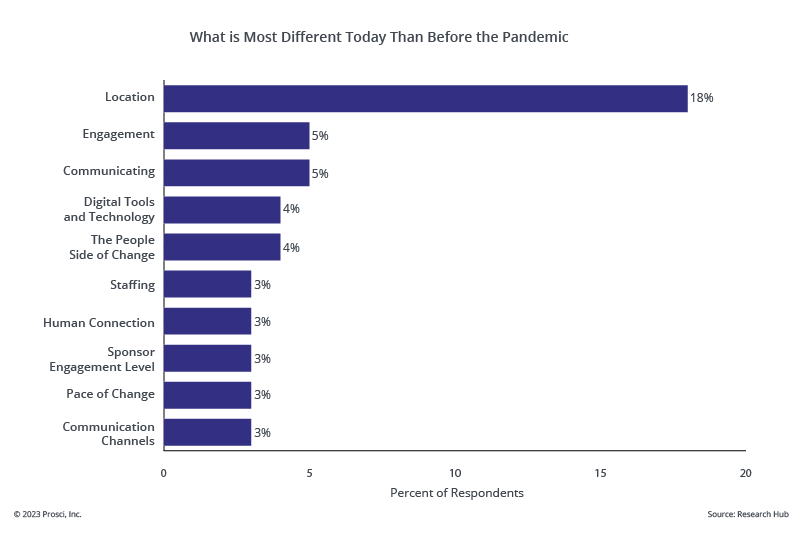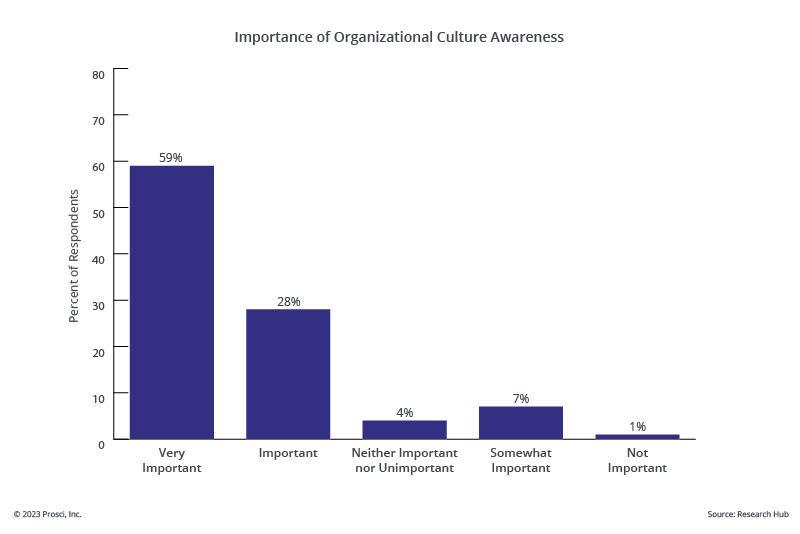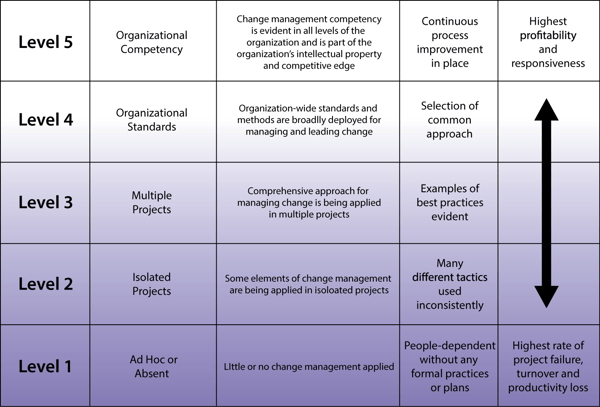Global Insights About Organizational Change

4 Mins
Published: August 23, 2023

Leaders everywhere continue to reshape their approaches to meet the changing needs of their organizations. Although the pandemic is officially over, there is still important work to do to help organizations and individuals continually adapt. Here are a just a few focus areas impacting global organizational changes today.
Continued Focus on
Virtual Work and Digitalization
Organizations will not return to the same model they had in early 2020 before we all went through the involuntary digital transformation brought about by the pandemic's impacts. Although some organizations have required full-time, in-office work, most continue to offer virtual or hybrid work arrangements because flexibility is essential to attracting and retaining diverse and productive talent today.
Participants in Prosci's research on the Top Contributors to Change Success in a Post-Pandemic World revealed that the most different aspects of change since before the pandemic were location (in-office, hybrid, remote, etc.), engaging employees virtually, and communicating with employees in a hybrid workplace.

The virtual work environment created a widespread shift in thinking, which won't simply swing back. Virtual work is ingrained in how organizations of all sizes and types, and in regions around the world, work now. Because of this, we continue to focus on adoption and effective use of changes when we cannot physically see the work being done, such as using systems and technology more to check on work performance, spot and resolve for resistant behaviors, and enhance interactivity.
I expect this even in regions or industries where remote office work was limited or nonexistent prior to the pandemic. Because they addressed the technical and learning challenges, put the needed infrastructure in place, and invested in digital systems and processes, most are continuing with hybrid work or focused on enhancing remote work to be both productive and to elevate the employee experience.
Expectations Around People
Not long ago, organizations were working from an employer perspective. The labor shortage and what was deemed "The Great Resignation" made flexibility important to candidates choosing between offers. Today, the dynamic has shifted a little and the labor market is not as tight, but if you are going to attract and retain top talent, offering them flexibility is still important. I was recently listening to a podcast where the CHRO of a Fortune 50 company was describing the expectations of Generation Z, who are now almost 30% of workers. They fully expect flexibility in where and how they work. If we ignore this segment of the workforce, we will be missing out and likely setting ourselves up for a difficult time as more Baby Boomers and Generation X employees retire.
Work locations and schedules aside, organizations need to be flexible by understanding how people react to change. Prosci's research on Emergent Contributors to Change Success supports this notion. Study participants reported that they are seeing an increasing importance in building organizational flexibility and agility, leveraging technology and digital approaches, creating collaboration and connectedness in a hybrid workplace, and defining and measuring success.
Requiring people to adopt new technologies, return to an on-premises role, or adjust to other significant changes in the way they work without helping them through their transitions leads to significant consequences for organizations. Having good change management capabilities in place is critical because this employer-employee dynamic will continue to shift over time.
Cultural Differences Affect
How People Adopt Changes
Cultural differences have always impacted how people respond to change, and our increasingly global organizations need to consider this in their approaches to managing change. Differences in the way we communicate—such as open and informal versus structured and hierarchical— influence our success. Or the degree to which organizations focus on the group versus the individual. Or the way decisions get made. All these choices matter. This is a challenge for all organizations, especially those dealing with multicultural dynamics due to geographic or organizational history, such as mergers and acquisitions.
To address cultural differences, I encourage leaders to stay engaged with their people to understand how they are adapting to the changes. Leaders should also spend time understanding the impacts cultural dynamics have on how people respond to changes, the ways they are communicated, and the personal interactions involved. Change practitioners should assess and adapt their deployment plans much more frequently. Communities of practice should also increase their level of focus on local adoption, perhaps deploying change ambassador networks to help tailor change management activities appropriately.

Importance of
Culture Transformation
During the height of the pandemic, organizations reached out for help with culture transformation initiatives because leaders recognized that the work environment, the way people interact, and core-capability expectations needed to be adjusted.
But the need for culture transformation is even greater in organizations today because culture is always adapting and morphing. Some of the norms I saw as effective in the early 2000s are no longer so. With all the virtual capabilities we acquired through digital transformations, we enabled workplaces that are increasingly global. We shifted away from hiring people to work in a local office during standard business hours, five days a week. Now we're cross-functional, collaborating with teams who are based virtually anywhere, and working the schedule they choose to a degree.
Given these and other changes, it makes sense that participants in Prosci's Best Practices in Change Management – 12th Edition study continue to cite culture change as a priority, with 87% rating organizational culture awareness as very important or important. In the study, culture change was the second most common type of project organizations were undertaking (16%), just behind IT software upgrade/implementation (17%).

Our research team has also done interesting work on how to adapt change management for situations like this. We focus on driving forces, which make change easier to implement, and restraining forces, which make it more difficult. Because many aspects of culture transformation involve behavior changes, we can map this information to how people accept change using the ADKAR Model and then put together the strategies for effective adoption.
Employee Engagement
and Mitigating Resistance
Working through high levels of change means organizations are experiencing high levels of resistance from people who must adopt and use the changes in their daily work. To help people develop and maintain the ability to handle multiple, concurrent changes, I suggest focusing on a holistic, organizational approach. First, everyone in the organization—sponsors, people managers, project team members, and front-line employees—must understand their role in change and be able to execute it. We call this building enterprise change management capability.
The approach should incorporate the concept of agility to help individuals and teams embrace the idea that frequent, minor changes are now expected. It begins by establishing clear expectations and then conducting regular assessments to determine which groups are being affected, as well as the timing and manner of the changes. By understanding if a particular group is facing multiple changes simultaneously, you can prioritize decisions and spread out the changes to minimize impacts.
Navigating ongoing change also requires a comprehensive understanding of your organization's change management maturity. Conducting a maturity assessment across five key areas offers clarity about your strengths and areas for improvement. Our research has shown that organizations with lower change management maturity struggle with multiple, fast-paced changes while those with higher maturity levels exhibit far greater resilience and adaptability.
Prosci Change Management Maturity Model
Change Adoption
Is an Individual Process
Regardless of geography and culture, people adjust to changes at their own pace. It is a mistake for organizations to assume that everyone will accept or resist change in the same way. Individual decisions about change are undeniable, which is why change management is essential for the success of all organizations.


